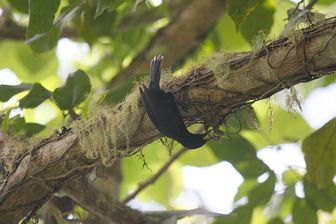Jamaican Blackbird
The Jamaican Blackbird is a small icterid with all black plumage. It has a short tail that is often frayed . It is strictly arboreal and has a wheezing call. Pairs occupy large territories in a variety of wet montane forest types, including elfin and mist forests, that have substantial epiphytes and mosses on the trees.

Original source: dominic sheronyPermission(Reusing this file)This image, which was originally posted to Flickr.com, was uploaded to Commons using Flickr upload bot on 12:42, 29 May 2008 (UTC) by Dysmorodrepanis (talk). On that date it was licensed under the license below. This file is licensed under the Creative Commons Attribution-Share Alike 2.0 Generic license.You are free:to share – to copy, distribute and transmit the work
Author: dominic sheronyPermission(Reusing this file)This image, which was originally posted to Flickr.com, was uploaded to Commons using Flickr upload bot on 12:42, 29 May 2008 (UTC) by Dysmorodrepanis (talk). On that date it was licensed under the license below. This file is licensed under the Creative Commons Attribution-Share Alike 2.0 Generic license.You are free:to share – to copy, distribute and transmit the work
The Jamaican Blackbird is classified as Endangered (EN), considered to be facing a very high risk of extinction in the wild.
The Jamaican Blackbird (Nesopsar nigerrimus) is a species of bird in the New World blackbird and oriole family Icteridae. It is the only species (monotypic) in the genus Nesopsar. The species has sometimes been included in the genus Agelaius, but molecular systematics have shown it not be closely related to any living blackbird or grackle. The species is endemic to Jamaica, where it is restricted to Cockpit Country, some central areas and the Blue and John Crow Mountains. More
Jamaican blackbirds spend most of their time foraging in the forest canopy. They vocalize frequently. FEEDING ECOLOGY AND DIET Forage in trees, searching epiphytes for invertebrate food. REPRODUCTIVE BIOLOGY Monogamous. The bulky nest is constructed of rootlets and epiphytic orchids, and is placed against the trunk of a tree in the lower canopy. Two eggs are laid in May–July. Incubation is about 14 days. Single brooded. CONSERVATION STATUS Endangered. More
The Jamaican blackbird can be seen in mature, wet limestone forest with a high density of epiphytes and bromeliads. It is found between 510 and 2,200 metres above sea level, but avoids hillsides with strong winds (2). - This monogamous species spends the majority of its time with its partner. They echo one another’s calls and fly above the canopy to perform a song-flight when separated. More
The Jamaican Blackbird is the only species in a Jamaican endemic genus of bird species, with the result that it is not closely related to any other Jamaican bird or indeed to any other species of bird world-wide. How it got here and where its closes relatives are to be found are totally unknown to science. It is possibly our islands most endangered bird species and is in urgent need of scientific study. More
The past and current major threat to the Jamaican blackbird is habitat destruction as a result of afforestation with Caribbean pine (Pinus caribaea), and clearance for the creation of coffee plantations. Trees are also removed for making charcoal, and small-scale farming and development is a constant threat to the area of habitat that remains. This bird species is particularly threatened by the removal of large trees as these are the support for the bromeliads and epiphytes that the blackbird forages amongst. More
Six Jamaican Blackbirds & 2 Crested Quail Doves Spotted on a Birding Excursion from Lime Tree Farm! - Last week 3 keen birders from Canada, Simon Gawn, Paul & Ian Jones visited Lime Tree Farm for an intensive 3 days of Birding, on the first day we visited Cinchona where 17 of Jamaica's endemic bird species were sighted along with a a few other rare birds to Jamaica such as a LIncoln Sparrow & a Rufus Throated Solitair, a Multi Island Endemic whose haunting whistle More
the best spot for Jamaican Blackbird, and also good for Jamaican Crow, and Black-billed Parrot. More
the Jamaican blackbird (Nesopsar nigerrimus ) feeds on insects in montane forests, we predicted that this species should have large, exclusive territories, monogamy with dual parental care, and advertising songs consisting of frequency-modulated tones, all in contrast to blackbirds in the genus Agelaius, the closest phylogenetic relatives of Nesopsar. During studies in montane forest in Jamaica, we documented that Jamaican blackbirds exploit sparse, evenly distributed insects in the canopy of montane forest. More
Family : Icteridae
Genus : Nesopsar
Species : nigerrimus
Authority : (Osburn, 1859)
